Short of noodling and spearfishing, fishing with just a line and a hook is the simplest and most affordable form of fishing you can participate in.
Handline fishing, or fishing without a fishing pole while still using a line and a hook, is popular worldwide and has been for centuries. With little equipment required, handline fishing can be a lifesaver in survival scenarios, a fun challenge, or just a viable way to catch fish to eat.
Keep reading for more details on fishing without a fishing rod, using just a line and hook, and a few other methods that require very little additional equipment.
Handline Fishing Explained and Methods
Here are 15 different ways to handline fish, including some simple methods to replace your pole, some tips for fishing with minimal equipment, and how to find bait if you don’t have any.
Also, check local laws and regulations, as some areas will restrict artificial or live bait use and might have bans on specific handline fishing methods.
1. Why You Should Consider Fishing With Just A Hook And Line
Fishing with just a hook and a line can be a simple and rewarding way to enjoy the sport of fishing.
One of the primary benefits is the minimal amount of equipment required, making it an affordable and accessible option for beginners and experienced anglers alike.
It also allows for a more natural presentation of the bait, which can be appealing to fish in clear or heavily fished waters.
Fishing with just a hook and line can also be a meditative and relaxing experience, as it requires patience and focus.
It can also provide a sense of connection with nature and the environment as you become more attuned to the movements and behaviors of the fish and other wildlife around you.
In addition, fishing with just a hook and line can be a sustainable and conservation-focused approach to fishing, as it reduces the potential for harm to fish and the surrounding ecosystem.

2. Tips To Stay Safe While Handline Fishing
While fishing with just a hook and fishing line, there are a few things to remember to keep you from getting injured while on the water.
Most of them are common sense that you should always keep in mind while fishing, but here are a few less obvious ones.
Use gloves or a rag to protect your hands from the line: a large fish might take your line harder and faster than you are expecting, so using gloves or something to protect your hands can keep the line from cutting into your skin.
Tie the end of the line to a sturdy base: a device you can hold to control your line, such as the ones we’ll discuss later, or a sturdy tree or pole to which you can attach the line.
Using an anchor point will keep the fish from taking the whole line if you aren’t ready.
3. Weight Is Your Friend
When fishing with just a line and hook, adding weight can help you cast farther and get your hook down to the desired depth.
Depending on the conditions and the type of fish you are targeting, you may need to experiment with different weights to find the right balance.
4. Choosing The Right Line
Your type of line can significantly impact your success when fishing with just a hook and line. Monofilament is popular for its versatility, while fluorocarbon is often used for its invisibility in the water.
Braided line can also be a good choice for its strength and sensitivity.
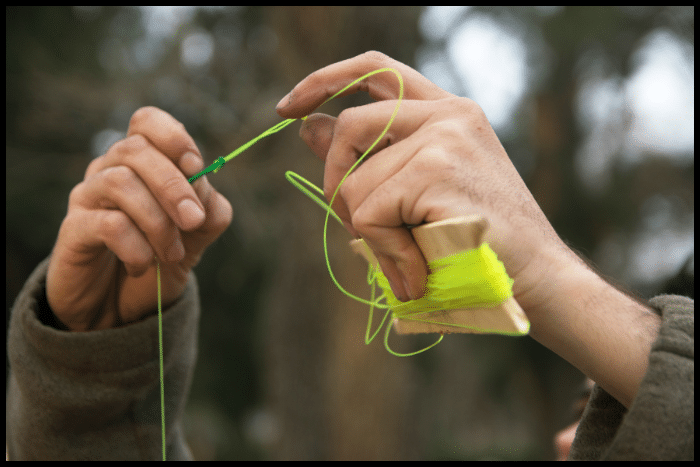
5. Choosing The Right Hook
The type of hook you choose will depend on the size and species of fish you are targeting. Circle hooks are popular for catch-and-release fishing, while J-hooks are often used for bait fishing.
Choosing the right size and style of hook for the fish you are targeting is essential.
6. Other Terminal Tackle To Consider While Handlining
In addition to weight and hooks, there are other terminal tackle items you may want to consider when fishing with just a line and hook.
Swivels can help prevent line twists, while floats or bobbers can help you detect when a fish is biting.
7. Tips For Fishing With Live Bait, Line, And A Hook
When fishing with live bait, keep it alive and healthy as long as possible. Use an aerator or change the water frequently in your bait container.
Hook your bait gently to avoid killing it prematurely. Keep your bait moving to make it more enticing to the fish.
8. How To Fish By Hand With Lures
When fishing with lures, choose one that mimics the prey of the fish you are trying to catch. Vary the speed and depth of your retrieve to see what works best.
Use a rhythmic pattern to mimic the movement of live prey. Keep your line tight so you can feel any bites.
For handline fishing, lures that use a steady retrieve work great, and small/medium size lures are much easier on the hand than a large lure.
Spoons, spinners, and jigs are all great options while using a large glide bait might be challenging.
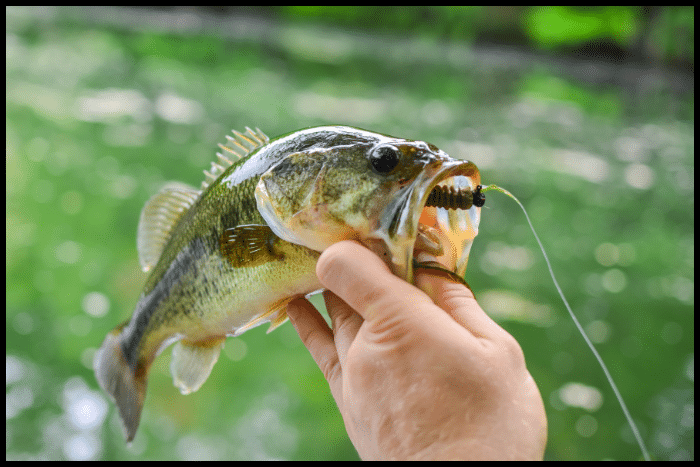
9. How To Find Live Bait Near Your Fishing Spot
Look for areas with vegetation or structure in the water where baitfish may congregate. Use a cast net to catch baitfish or worms or a trap to catch crayfish.
Logs and rocks can be great places to find insects, and anything you find near the fishing spot will likely already be a part of the diet of the fish.
10. How To Reel In And Land The Fish
When you feel a bite, wait for a second or two before setting the hook to ensure the fish has the bait in its mouth. Once you’ve set the hook, keep your line tight and reel in the fish steadily.
When you get the fish close to shore or your boat, use a net or your hand to lift it from the water.
11. Gear Storage For Handlining
Gear storage is important when fishing with just a line and hook. Keep your hooks, weights, and lures in a tackle box or pouch to keep them organized and easily accessible.
Good storage systems will save you time and frustration while on the water.
A small tin will work for holding hooks and lines, and when wrapped up nicely and stored, try and protect your gear will last a long time for many fish to come!
12. How To Find Good Fishing Spots
When looking for good fishing spots, research the area and ask local anglers for advice. Look for areas with structure, such as rocks or logs, where fish may hide.
Additionally, fish in areas with moving water, such as the mouth of a stream or inlet, where fish may feed.
Check out our species-specific articles that will walk you through all the best areas to find your target species. Fishing pole or not, the fish will still be in the same spot.
13. Catch And Release Tips
If you plan to catch and release your fish, handle them carefully to minimize injury. Wet your hands before handling the fish to prevent removing their protective slime coating.
Also, be sure only to handle a fish by the lip if it has a sturdy jaw- think bass and the like. Trout and other delicate fish should be handled by holding them around the body or using a net.
I have an article discussing why you shouldn’t lip a trout to educate you more on the topic.
And only handle a fish by its gills if you plan on keeping it.
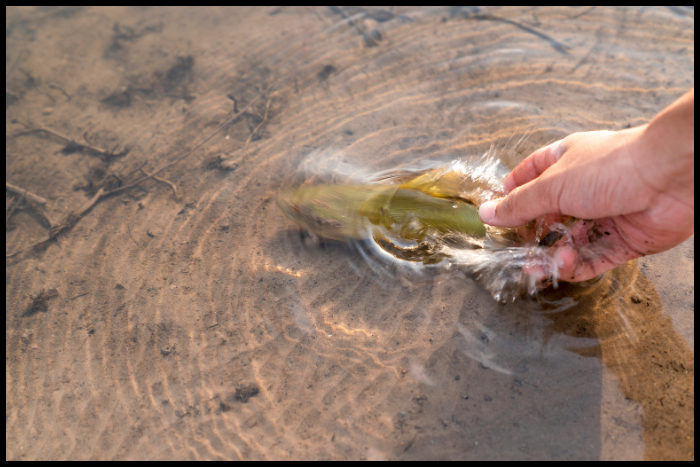
14. Preparing A Caught Fish For Eating
If you plan to eat your catch, clean and fillet it properly. Preparing the fish will ensure that you are not wasting any and that it is safe to eat.
Bring a cooler with ice to keep your fish fresh until you can clean and prepare it.
Keeping your fish alive until you plan to eat it if you plan to do so the same day is a good option, or bleeding the fish by cutting its gills is the better option if you plan on putting the fish on ice or in a fridge for a day or two or freezing it.
Handline Reel Options
Fishing with just a line and hook is fun and rewarding, but many styles of reels are designed for handline fishing that doesn’t require a pole or anything else.
They don’t have any moving mechanisms and instead rely on the angler manually wrapping the fishing line around.
1. Traditional Handline Reels
Traditional handline reels are simple and easy to use, consisting of a spool with a handle and a length of line.
They are lightweight, portable, and affordable, making them a popular choice for anglers who enjoy the simplicity of fishing with just a line and hook.
The spools often resemble the handles used when flying kites with the line wrapped around them, and in fact, a sturdy kite spool would make a great handline fishing reel.
2. “Hobo” Handline Fishing Reels
“Hobo” handline fishing reels are made from plastic bottles, PVC pipes, or discarded wooden spools. They are versatile and can be customized to suit individual needs and preferences.
Despite their low cost, they can effectively catch various fish species.
Many “Hobo” fishing reels also have storage inside for hooks, weights, and other tackle and bait without additional space on the reel, perfect for a pocket fishing kit!
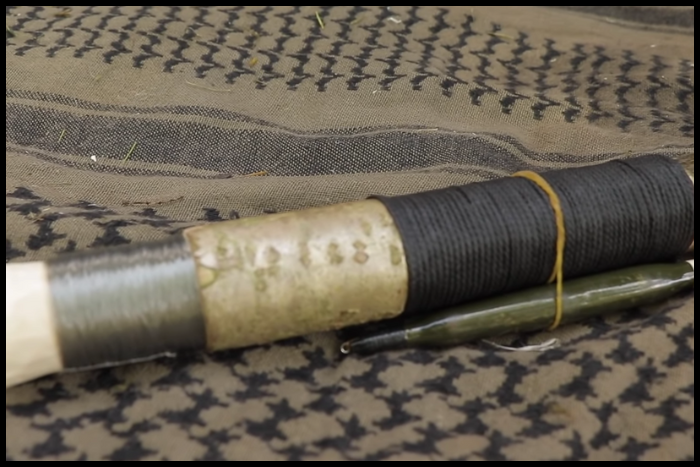
3. Handlining With A YoYo Reel
Fishing with a Cuban yoyo, also known as a Cuban reel, is a traditional and straightforward method of fishing that has been used for centuries.
The angler holds the handle and pulls the line by hand, rewinding the line onto the spool with the help of the drag.
The Cuban yoyo is versatile and can catch various fish species in freshwater or saltwater, making it a popular choice among anglers of all skill levels.
Its compact size and ease of use make it ideal for hiking or traveling to remote locations where conventional tackle may not be practical.
When used correctly, the Cuban yoyo can be an effective and rewarding way to catch fish.
Check out my article on the best fishing methods discussing the more conventional ways of fishing.
4. Rope Backing
Rope backing is a popular option for handline fishing, allowing you to easily retrieve your line without tangles.
This method involves attaching a long rope to the back of your handline reel, which can be thrown into the water to sink to the bottom.
The rope provides a strong anchor point and makes it easier to retrieve your line.
Using a rope backing also makes the line easier to handle, and when reeling in, big fish can keep your hands from getting torn up.
5. Trotlines And Similar Methods
Trotlines and similar methods involve attaching a long line with multiple hooks at intervals along the line. This method is popular for catching multiple fish at once and is commonly used in commercial fishing.
These methods use live bait and are great for set it and forget it fishing while still only requiring a line and hooks.
Trotlines are one of the best options for fishing in a survival situation or as a way to catch many fish quickly.
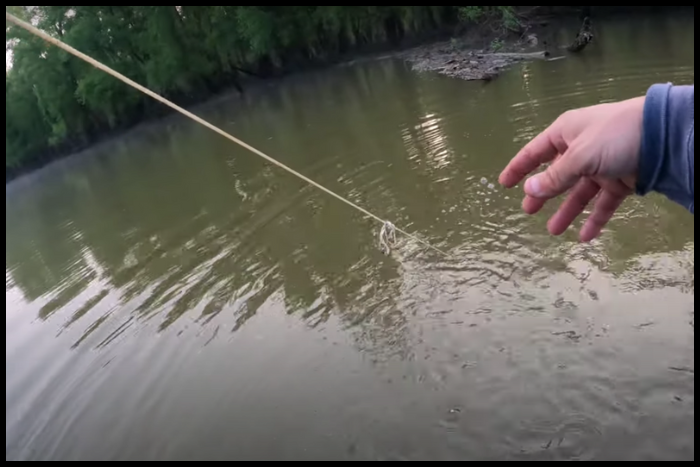
6. The Chill-N-Reel
While the Chill-N-Reel might be a more specific product than the others mentioned on this list, it is truly a unique and new innovation in an old industry.
The Chill-N-Reel is a handline reel designed for ice fishing, but it can also be used in other applications.
It features a unique design that allows the user to keep their drink of choice in a koozie while having a line in the water.
This reel is a perfect gift for the angler in your life or a viable fishing option for fun handline fishing.
In case you want to look at some other ice fishing reels, I have a few reliable recommendations in my article on the best ice fishing reels.
Conclusion
Handline fishing is a simple and sustainable way to enjoy fishing without breaking the bank.
With these tips and methods, you can try handline fishing and experience a new way of fishing while connecting with nature.
Handline fishing can also be an excellent option for hiking where weight is a priority or an option to keep in an emergency pack that might save your life one day.
Because you never know when you might need to do more with less.
